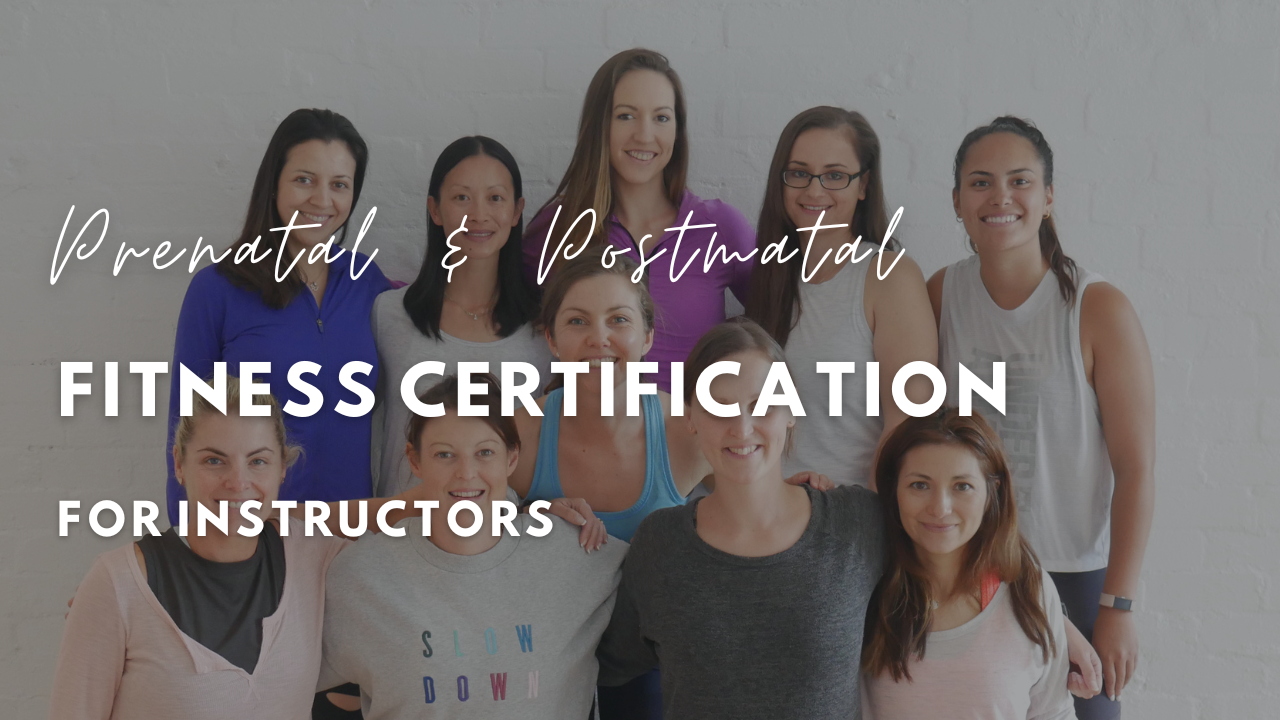Guidelines for Exercising During Pregnancy

Guidelines for Exercising During Pregnancy
I am about to share with you all you need to know when it comes to exercise during pregnancy. It starts with only including safe prenatal exercises into your training program.
As a mama, I know first hand how exercising each week of my pregnancy helped keep me fit and strong as well as empowering me to enjoy a speedier postpartum recovery.
And one of the most important points is that when pregnant, the exercises you perform must be modified!
I also want to talk about some guidelines you should always follow. To keep both you and baby safe! Let's get started.
Key Guidelines and Recommendations ( RANZCOG / DoH 2025)
1. Aerobic Activity
150-300 min/week moderate OR 75-150 min/week vigorous (or combo)
Spread over 3-5 days. Moderate = "talk test" (can chat, not sing).
Vigorous = short sentences only.
2. Strength Training
≥2 days/week. Light-moderate resistance (bands, bodyweight). Focus on major muscle groups.
3. Pelvic Floor Exercises
Daily Kegels + integrated core work (e.g., TA activation). Start early.
4. Flexibility/Balance
As needed. Yoga/Pilates (modified). Avoid deep twists/supine after 16 weeks.
5. Sedentary Time
Limit. Break up sitting >1 hr. Stand/walk every 30 min.
Is Exercise during Pregnancy Recommended?
Yes! Women without complications should participate in appropriate prenatal strength-conditioning exercises. Regular exercise is what will keep you motivated and on track.
A reasonable goal should be to maintain a good fitness level throughout your pregnancy. It's about you.
Benefits for Mum and Baby
Mum
↓ Gestational diabetes (30 %) & preeclampsia risk
↓ Excessive weight gain & C-section odds
↑ Mood, energy, sleep
↓ Back/pelvic pain (50 % reduction)
Baby
↓ Macrosomia (large baby)
↑ Neurodevelopment & birth weight control
No harm to fetal growth/heart rate
↓ Neonatal jaundice
It's about baby!
I know from first-hand experience just how beneficial exercise during pregnancy can be.
I often hear from my clients how they were physically prepared for labor and delivery. How they enjoyed a speedier post-baby recovery.
How they experienced less pregnancy ailments.
No studies have substantiated previous views that exercise poses risks for mother and child in a healthy pregnancy.
Why is Exercise Important?
It is important to exercise during pregnancy for many reasons. In particular, moderate exercise during all stages and weeks of pregnancy is extremely beneficial for both you and your growing baby.
Besides the fact that exercise makes you feel good; there are also a number of physiological reasons why working out is worthwhile.
During Pregnancy, Regular Exercise Can:
1. Help prevent pregnancy-related constipation.
2. Release endorphins to improve your mood.
3. Help you maintain your pre-pregnancy fitness levels.
4. Help you maintain a healthy weight
5. Help improve sleep quality.
6. Help build strengthen your core muscles.
How Often Should You Exercise when Pregnant?
Ideally, you should aim to workout at least 3 - 5 days a week. The Royal College of Obstetricians and Gynaecologists recommend you should aim to be active on most days of the week.
RANZCOG recommend accumulating 150 to 300 minutes of moderate-intensity physical activity each week.
Is Exercising for Every Woman?
Exercise in pregnancy is recommended for women who are already active. And are experiencing a healthy pregnancy without complications.
Exercise during pregnancy is recommended for women who have never exercised before.
Before Pregnancy
If you were physically inactive before getting pregnant, then you can still start now. Just be sure to join in an appropriate prenatal exercise class.
Exercise may not be recommended if you have a serious injury or health issue.
The decision as to whether or not you should exercises will come down to taking your doctor's advice.
Always check with a doctor before starting an exercise program. There may be some situations where exercise may not be advised such as pre-eclampsia, placenta praevia, multiple pregnancy or pelvic instability.
What are the Best Pregnancy Exercises to Do?
My online program provides you with only the best pregnancy-safe exercises for every week of your pregnancy.
You deserve nothing less!
My workouts will help you maintain or build your muscle tone which can help reduce the likelihood of hip, pelvic pain, back or neck pain.
Also, my cardio workouts will help you improve your cardiovascular fitness which in turn helps you to maintain a healthy pregnancy weight.
Safe Pregnancy Workouts
3. Walking
4. Low-impact exercises ( riding a stationary exercise bike)
5. Swimming / Water Aerobics
6. Prenatal strengthening exercise
7. Pelvic floor exercises such as your Kegels
Walking during Pregnancy
There are various ways to get fit when pregnant besides participating in an organized class, exercise program or trainer.
Let' start with walking during pregnancy. Walking is a great way to get outside, get some fresh air and get fit at the same time.
Brisk walking is low-impact and you can monitor your heart rate and intensity by making sure you are able to carry-on a conversation.
Unlike running, walking is not high impact.
Swimming when pregnant is another favorite of mine. I teach PregAqua which is our own pregnancy water classes. Being in water has many benefits due to the buoyancy factor.
Just be sure to follow the guidelines with whatever activity you choose.
Benefits of Exercise during Pregnancy
Exercising during pregnancy will improve both your physical and mental well-being. It will also help you to attain, and maintain, a healthy pregnancy weight.
This in turn will help you in returning to your pre-baby weight more quickly.
Maintaining a healthy weight also reduces the risk of developing gestational diabetes. This is more common in mothers who are overweight.
Other Benefits:
1. Helps reduce pregnancy back pain.
2. Reduces bloating and eases constipation.
3. Assist in reducing swelling.
4. May help prevent, or treat, gestational diabetes.
6. Boosts energy and improves your mood.
7. Can improve your posture.
8. Increases muscle strength and also muscle tone.
9. Muscle endurance.
10. Improves sleep.
You Must Train for Pregnancy
Yes, exercise during pregnancy is recommended. But you should resist trying to achieve peak fitness or training for a sporting event.
Pregnancy is not the time to try and set new 'personal bests' Or push your body to the limits in terms of intensity. This as this may cause harm to you or your baby.
You should also select activities that will minimise the risk of loss of balance. That avoid high-impact movements or cause trauma to the joints and ligaments.
First Trimester Pregnancy Yoga Workout
Abdominal Strengthening Exercises
You should avoid exercises in the supine position after approximately 16 weeks’ gestation.
Some women may experience symptomatic hypotension from compression of the vena cava. This is caused by the pregnant uterus. Your ability to perform abdominal exercises may be impeded by diastasis recti, so listen to your body.
And take note of warning signs.
I strongly advise against doing old traditional sit-ups or planks when pregnant. There are safer ways to strengthen your core such as modified core strengthening exercises.
Exercise Intensity for Pregnant Women
There is an increase of 10 to 15 beats per minute in resting heart rate in pregnancy. Many non-pregnant women use conventional heart rate target zones as a guide for intensity.
However, during pregnancy you should be able to talk while exercising.
A better guide for intensity is to use the Borg's scale of perceived exertion. And aim for a rating of between 12 to 14.
Safety Precautions
1. Avoid activities or sports that require balance. (skiing, horseback riding, ice skating, gymnastics)
2. Follow healthy and appropriate pregnancy exercise guidelines.
3. Stay well-hydrated by drinking plenty of water.
Your Prenatal Exercise Program
1. A Warm-up
Gradual warm-ups and warm-downs for circulation and avoidance of blood pooling. These should not be ballistic in nature nor should they contain high-impact movements.
2. Strength Training
Prenatal strength training with an emphasis on pregnancy specific muscles. (e.g. pelvic floor) Having stronger legs will assist you with many of the birthing positions.
Improving your overall strength will help you recover more quickly postpartum and will help to prevent lower back issues.
3. Modified Workouts
Modified strength training appropriate for pregnant women. Yoga is recommended, but many yoga positions that are safe for a non-pregnant woman are no longer safe when pregnant.
Ballistic, high-impact activities that are often used in HIIT classes must be avoided. As is, lifting heavy weights or striving to reach new personal bests.
4. Modifications for standing.
Your balance can be impacted when pregnant. And you must also avoid exercising in the supine position especially later on in pregnancy.
5. Stretching
Flexibility training limited to a comfortable range of movement. Due to the pregnancy hormone relaxin, your joints are more subtle and susceptible to injury.
So don't push too much and only include safe pregnancy stretches in your workouts.
What Else?
1. Appropriate non-impact exercise styles.
2. Modified exercise programs when risk of overheating is raised.
3. Exercises that do not exacerbate pregnancy related musculoskeletal condition.
4. Relaxation and recovery.
6. Required rest breaks.
7. Workouts should be progressive, but not at a high intensity.
You Should Avoid
Sudden changes of intensity and position. High impact ballistic movements. Jerky or ballistic movements must all be avoided!
Related: Pregnancy target heart rate guidelines
But what else should you avoid?
You will want to avoid any exercise that places significant load on the abdominals or pelvic floor. Avoid high intensity exercise that makes you feel hot, exhausted or excessively sweat.
Stay clear of any exercise that involves holding your breath ( valsalva manoeuvre )
What Else?
Avoid extreme exercises in stationary standing that may increase the risk of fainting.
I also want you to avoid contact activities (to minimize risk of falls and blows to the abdomen), exercises that may cause or exacerbate any pregnancy related condition or stretching beyond a comfortable range of movement.
Why?
Because overstretching due to increased joint and ligament flexibility.
Your Past Exercise History
When pregnant, you should continue to exercise according to these prenatal exercise guidelines. I want you to modify your exercise (intensity, type and duration). This is in accordance with the general physiological changes associated with pregnancy.
If you were previously inactive prior to getting pregnant, then you need to start at a low level.
Then progress gradually.
In the absence of any medical issues, exercise can be undertaken on most days. With consideration of variables including intensity, duration and recovery.
Your recovery days are also very important and trying to exercise every day may cause you to overexert yourself.
Every Pregnancy is Different
Every pregnancy is different, including yours! Women can develop pregnancy related issues that have exercise implications at various times.
So it is vital that you seek approval from your doctor prior to commencing any exercise program.
Keep them updated on what exercise workouts you are doing throughout your pregnancy.
At some point, they may need to modify your workouts. Or make recommendations to alter your program.
Stop Exercising if You Experience:
1. Vaginal bleeding.
2. Abdominal cramps or pain.
3. Chest pain or palpitations.
4. Blurred vision.
5. Excessive shortness of breath.
6. Dizziness or feeling faint.
8. Fainting.
9. Headaches.
10. New or persistent nausea or vomiting.
11. Calf pain or swelling, or unusual muscle weakness.
12. Any kind of pain or numbness.
Any Others?
Yes. Stop exercising if if experience excess fatigue after exercise, any intense or new back pain, contractions, leaking of amniotic fluid or reduced movements of baby.
Duration and Frequency of Exercise
It is recommended that your exercise session duration is limited to avoid overheating.
This is why many of my workouts and consist of short, appropriate pregnancy exercises. And avoid long duration high-intensity workouts.
Every individual is different.
So please select the right length of workout according to your personal requirements and abilities.
Women, with what is considered as a low-risk pregnancy, can engage in:
1. Moderate intensity exercise.
2. For 30 minutes a day.
3. 3-5 times a week.
Low risk pregnancies are those which are not otherwise constrained by medical or obstetric complications.
Exercise for Pregnant Women
Your health and well-being matters when pregnant. You need to be physically strong to carry your baby. And participating in medically endorsed prenatal classes will help you.
But you must only include pregnancy-safe first trimester exercises.
And remember your Kegel exercises!
If you are taking an in-studio class, make sure your instructor is qualified. Now is not the time to take risks. Would like to workout in the privacy of your own home? Then you will love my online workouts.
Are you a mom-to-be looking to stay fit and healthy during your pregnancy?
Join us in this comprehensive Pregnant Workout program designed specifically for expecting mothers!
We'll guide you through safe and effective exercises that can help you maintain your strength, flexibility, and overall well-being throughout your pregnancy journey.
Whether you're in your first trimester, second, or third trimester, our routine is tailored to accommodate your needs and energy levels.
We’ll cover essential warm-up techniques, low-impact cardio, strength training, and stretching exercises that are all pregnancy-friendly.
Discover the benefits of staying active while pregnant, including improved mood, better sleep, and reduced discomfort. Plus, learn tips on how to listen to your body and modify exercises as your pregnancy progresses.
Chat to Your Doctor
Don't forget to consult with your healthcare provider before starting any new workout routine. Let's embark on this fitness journey together and empower each other for a healthy pregnancy!
Subscribe for more prenatal fitness tips and routines tailored for moms-to-be. Remember to like, comment, and share your experiences with fellow expectant mothers.
Stay fit, stay healthy, and enjoy your pregnancy!





